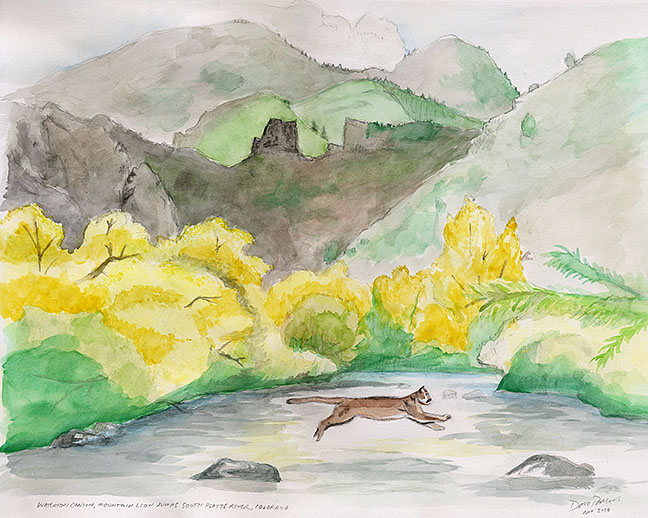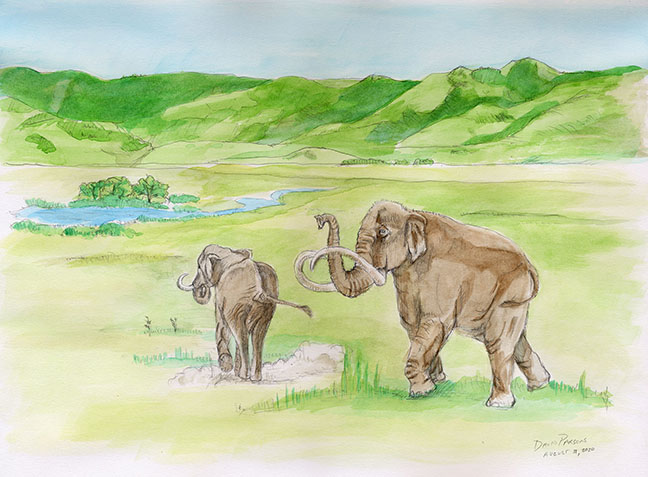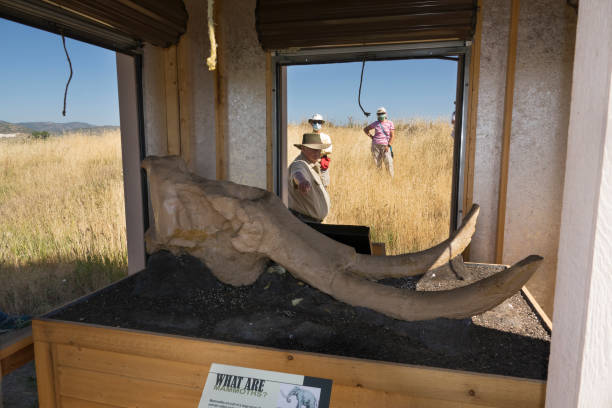 |
 |
 |
   |
Colorado’s South Platte River Valley September 20, 2020 Photos, artwork and text by Dave Parsons On the Run Rocks and dirt rolled and slid down the steep hillside as bighorn sheep climbed wildly up towards the cliffs. Running in a line, their white rear ends converged on a high, rocky point in the canyon. Bunching up and bumping into one another like jockeying race horses, the group of over twenty stopped in a tight cluster and began looking back wildly in the direction they had just run. Three young males with curving horns stood among a majority of juveniles, lambs and females as they continued to move higher along the canyon walls. In confusion, the group would backtrack not knowing who to follow or which direction to go. Undoubtedly, the scent of predator was wafting through the air, changing direction randomly as hot and cold currents blew up and down the South Platte River.
The October sun was now behind the mountains as shadows covered Waterton Canyon and the temperature began to drop. Fall colors painted the hillside with orange scrub oak while yellow willows and cottonwoods leaned over the river bank. Red sumac and Virginia creeper grew next to orange lichen covered granite boulders as the descending notes of a canyon wren drifted through the cliffs. Now standing still and with all eyes scanning, the young lambs began to bounce around and nervously nibble on dry blades of tall grass. Still on alert, the herd began to mill around the granite walls and mountain mahogany shrubs occasionally kicking down small rocks which clunked into other rocks on their descent. Searching along the river and the surrounding canyon walls, I could not see what had made the bighorn so nervous. Along the river, stands of scrub oak are usually filled with acorns and very popular with dining black bears. Mothers with cubs, male bears and bears of all colors, blond, red or black frequent this stretch along the river and even soak in the cooling waters of the river.
Relaxing a bit but still cautious, the herd stayed close to each other as I walked a mile away towards the mouth of the canyon, where the South Platte River emerges from the mountains onto the plains. Just a few days ago, I watched a gray fox carry a vole in his mouth while trotting along the dirt road in the shade of cottonwood trees. Coyotes also like this spot, hunting the numerous rabbits or deer fawns through the thick wild plum trees and scrub oak. Reaching a spot in the river cobbles, I found a clear view of the mountains through the thick trees as I set up my tripod. The sky grew darker and color began to glow in the clouds as I aimed my wide angle lens westwards towards the jagged cliffs and changing colors of the trees and sky. Fish were slapping down on the calm river after going airborne for insects.
Replaying the scene in my head, I closed my eyes and watched in slow motion that giant tail stretched straight out as he made that giant leap across the river surrounded by fall colors and canyon cliffs. Now I know why the bighorn were on edge over an hour ago. Looking at my time lapse photos in the camera, I could see the profile of a tiny mountain lion that had walked up and down the river bank and had even stood on one of the boulders in the middle of the river for a moment. With the sky growing dark, I pulled myself away from where the lion disappeared, retrieved my tripod and hiked back to civilization, occasionally looking back to scan the riverbank and hills. A Mammoth Site Circling in the distant blue sky, a hawk screeched as our tribe of modern Covid-19 masked humans walked across the rolling hills of dry prairie grass just over a mile away from the South Platte River. In the morning summer heat, we were looking for wildlife, extinct wildlife that lived during a cooler time in the last Ice Age. As glaciers were retreating, massive ice age megafauna like Columbian mammoths, huge bison, camels, horses, giant sloths, wolves, coyotes and pronghorn that once wandered through this grassy corridor were drawn to the refreshing water found at an ancient wetland spring now called Lamb Spring.
Crunching through the dry, brittle grass, it was easy to visualize a 13 foot tall Columbian mammoth looking to quench his thirst, lumbering across the ancient savannah, drawn to the cool waters of the now invisible spring, sucked dry by todays ever expanding sprawl of homes. Water has always been important to Coloradans, drawing endless wildlife as well as ancient and modern peoples to this patch of Front Range prairie. As Western kingbirds and waxwings searched for insects in the dry grasses, I pictured the various wildlife as well as early hunter-gatherers that walked along the plains and among the nearby foothills, red rocks and Rocky Mountains to the west. In this very spot, some of Colorado’s earliest wildlife and human inhabitants left numerous hints of their occupation for thousands of years providing solid evidence of early migration and perhaps rewriting the peopling of North America. Over 9,400 years ago, hunters butchered over 25 bison at the spring site leaving numerous stone tools among the bones including seven Cody points, a knife, scraper, cutting tool and numerous flakes. Human modified mammoth bones found deep in the soil were dated by the Denver Museum of Nature and Science to over 13,000 years old. In one of the earliest sedimentary layers dating to approximately 15,500 years ago, a heavily scarred, 33 pound river boulder found with broken mammoth limb bones suggests mammoth butchering once took place here. Mammoth long bones would have been broken on top of the boulder or anvil stone to access the protein rich marrow. According to archaeologists, the boulder, located where geological forces could not have moved the stone to the site, was most likely carried by humans from the South Platte River just over a mile away. One archaeologist even recreated breaking bones from a deceased zoo elephant on a very similar South Platte River boulder he fished out of the water. His cracking of long bones on the river rock produced the exact same scarring that still remained on the 15,500 year old model of anvil stone. Just to the south of Lamb Spring, at a smaller spring site named Scott Spring, a prairie dog unearthed even more megafauna remains, drilling his burrow through a mammoth tusk. This second site has potentially earlier human modified mammoth bones. More investigations are needed to discover additional ice age bones and artifacts where Ice Age Americans clearly hunted and used this spot repeatedly, inhabiting the area for thousands of years. Looking over the site as a hot wind blew through the dry grass, It’s good to know the 39 acres that make up the Lamb Spring Archaeological Preserve have been safeguarded from nearby housing construction in one of the fastest developing areas in Colorado. Standing in this spot and looking towards the foothills and Rocky Mountains as the South Platte River wanders across the plains, it’s easy to see why people and animals have been attracted to this area. For millennia, this natural wildlife migration corridor has followed the Front Range mountains North and south along the short grass prairie that once extended from Canada down to Mexico through Colorado. Millions of birds, from huge raptors to even the tiny hummingbird still navigate along the mountains today, many flying all the way from South America to the Canadian Arctic tundra.
For the first Americans, it must have been an amazing, if not daunting experience as an early traveler to wander the wild without borders and boundaries, walls or fences watching and hunting the giant herds of bison and massive ice age mammoths, wandering the South Platte River Valley while avoiding any sharp tooth-filled jaws. Watching my wife heft a replica mammoth long bone while inspecting the dig site gave me a deep appreciation of those die hard early peoples surviving by their wits in a wildlife filled world. As our group walked back to our comfortable vehicles with air conditioning, I’m glad there are pockets of wild remaining to spark our interest and imagination. All contents Copyright DaveParsons.com
|
Destinations in the Gallery
All contents copyright ©Dave Parsons
DP Home | Feature | Gallery | About






